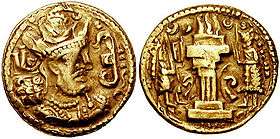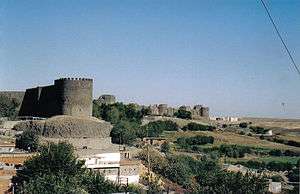Siege of Amida
The Siege of Amida took place when the Sassanians under Shapur II besieged the Roman city of Amida (modern Diyarbakır, Turkey) in 359 CE.
In this battle Ammianus Marcellinus, a historian of Greek origin from Antioch, was a Roman army officer; he described the siege in his work (Res Gestae).
Background
Persian
When Shapur II took control of the Sassanid Empire he sought to regain old territories previously lost to the Roman Empire. After crushing the Arabs in the south, he moved east to deal with nomadic forces, the most prominent being the Xionites.[5] Following a prolonged struggle from (353-358) the Xionites were forced to conclude a peace, and their king, Grumbates, accompanied Shapur II in the war against the Romans.[6][7] In 358 the Romans had failed to dissuade Shapur from attacking Mesopotamia, so the next year Shapur decided to invade.[8] Shapur started the western campaign in 359.
Roman
Emperor Constantius II had increasingly been doubting the loyalty of general Ursicinus. As a result, he did not give him command of the Roman forces in the East, and instead gave it to Sabinianus. As news of the Persian invasion spread, the civilian population of the region began to panic:
"Dispatch riders were sent at once to Cassian, the general of Mesopotamiam and Euphronius, then governor of the province, with orders to compel the country folk [farmers] to move with their families and all their livestock to places of safety. Carrhae was to be evacuated immediately, because of the weakness of its fortifications, and the whole country set on fire (see:scorched earth), to deprive the enemy of a source of fodder."
— Ammianus Marcellinus, Res Gestae, 18.7
In the panic which followed, several Roman legions chaotically escaped the Persian advance to the safety of Amida. These included the Legio XXX Ulpia Victrix and the Legio X Fretensis.
Preliminaries of the siege
It appears the Sassanid plan was to bypass difficult fortresses like Nisibis and to then march straight into Syria. When his forces approached Amida, the Sassanids were provoked into attacking the city.[9] This came about when the son of Grumbates, while inspecting the defences of Amida, was shot and killed with an arrow shot by the city garrison.[10] Ammianus described how the Grumbates, outraged at his son's death, demanded revenge from the Romans: he compares the death to that of Patroclus at Troy. The Sassanids began the attack with siege towers and attempted to take the city hastily, but were largely unsuccessful. Unable to gain a quick victory, Shapur had to commit to capturing Amida in order to appease his ally.
Siege
According to Ammianus Marcellinus
The king himself [Shapur II], mounted upon a charger and overtopping the others, rode before the whole army, wearing in place of a diadem a golden image of a ram's head set with precious stones, distinguished too by a great retinue of men of the highest rank and of various nations. But it was clear that he would merely try the effect of a conference on the defenders of the walls, since by the advice of Antoninus he was in haste to go elsewhere.
He continues with the account of how he reached the safety of the city just as the Sassanids were descending on the city:
I myself, having taken a direction apart from that of my comrades, was looking around to see what to do, when Verennianus, one of the guard, came up with an arrow in his thigh; and while at the earnest request of my colleague I was trying to pull it out, finding myself surrounded on all sides by the advancing Persians, I made up for the delay by breathless speed and aimed for the city, which from the point where we were attacked lay high up and could be approached only by a single very narrow ascent ; and this was made still narrower by mills which had been built on the cliffs for the purpose of making the paths. Here, mingled with the Persians, who were rushing to the higher ground with the same effort as ourselves, we remained motionless until sunrise of the next day, so crowded together that the bodies of the slain, held upright by the throng, could nowhere find room to fall, and that in front of me a soldier with his head cut in two, and split into equal halves by a powerful sword stroke, was so pressed on all sides that he stood erect like a stump.

The siege took 73 days. Shapur II attempted to capture the city several times but every time it ended with disaster. Early on in the siege a company of 70 of the elite Persian archers by aid of a Roman renegade gained entrance to a tower on the south side of the city, which was placed on the bank of the Euphrates. But the Romans reacted promptly and recaptured it, destroying the intruders. At the same time, repeated assaults on the walls were repulsed by the garrison, and many of the Persian siege towers were set on fire.[11] During the siege, plague broke out in Amida but ended after ten days by a light rain.[12]
At one point two Gallic legions which were stationed in the city, anxious to prove their courage in a hand-to hand fight, and infuriated by the sight of Roman captives being hauled in to the enemy camp by Persian raiders who were devastating the country, persuaded their commanders to allow them to carry out a night attack on the Persian camp. Although a slight noise warned the Persians in time to prevent their total destruction, the Gauls inflicted heavy casualties before retiring in good order within the walls.[13]
Mounting casualties, however, only infuriated Shapur and his barbarian allies. Although all their siege towers were destroyed by the skillful disposition and expeditious employment of the Roman scorpions, they were able to erect mounds of earth against the walls, which the Romans countered by building higher mounds within the circuit of the city, from which to aim their missiles against the Persians on the mounds lower down. Ultimately, one of the improvised towers of the Romans collapsed under the repeated shocks of the Persian missile-engines. The Persians were thus enabled to extend their mounds to the ramparts and scale the battlements of the city. Shapur's army made its long-delayed entrance into the fortress, the obstinacy of which was punished by a promiscuous massacre. Aelianus the count, who had directed the defense, with all his principal officers who survived, were subjected to crucifixion.[14]
Outcome

After the capture of the city, the remnants of the garrison and inhabitants were put to the sword. Autumn having arrived, the Persians could advance no further. Aside from having wasted the campaign season in the reduction of a single unimportant city, Shapur II had lost as many as 30,000 in the siege, and his barbarian allies from the east deserted him due to the heavy losses they had sustained;[15] According to Ammianus, Shapur's happy revels after the sack were merely a disguise for his frustration at having failed to make any significant conquests despite the loss of 30% of his enormous army.[16]
In the following year (360) Shapur II renewed his invasion and captured the key border fortresses Bazbde and Singara, killing and capturing five entire Roman legions, but again suffering high casualties.[17] In spring of the next year Constantius II who had spent the winter in Constantinople recruiting his forces, finally arrived in the east. Shapur's strategy was to refortify and hold on to the fortresses he had captured and avoid a pitched battle. Constantius directed his efforts towards retaking Bazbde, but met an unexpectedly strong resistance; diverted from his purpose by the revolt of Julian which had arisen meanwhile in Gaul, Constantius abandoned the siege on the approach of winter, heading west.[18] He died shortly after Antioch of a fever contracted in the unhealthy weather;
At the accession of Julian, Shapur desired to conclude a peace, being somewhat alarmed by the new emperor's formidable repute as a warrior and general; but the Apostate was impervious to Shapur's entreaties. In 363, Emperor Julian, at the head of a strong army, invaded Persia and advanced to take Ctesiphon. But despite a good start to the campaign he was killed in battle on the retreat. His successor Jovian signed a treaty of peace, by which the districts on the Tigris and Nisibis (totalling five Roman provinces) were ceded to the Persians and the Romans relinquished the right to interfere in Armenia.
See also
References
- ↑ From Constantine to Julian: Pagan and Byzantine Views: A Source History "359 (oct.) Amida fell to Shapur after a long siege of seventy-three days."
- ↑ Ammianus Marcellinus (1982). Res Gestae. Cambridge, MA: Harvard University Press. pp. 18.8.2.
- ↑ Ammianus Marcellinus. Res Gestae. pp. 19.9.9.
- ↑ Ammianus Marcellinus. Res Gestae. pp. 19.9.9.
- ↑ Ammianus Marcellinus (1982). Res Gestae. Cambridge, MA: Harvard University Press. pp. 16.9.4.
- ↑ Ammianus Marcellinus (1982). Res Gestae. Cambridge MA: Harvard University Press. pp. 18.8.2.
- ↑ Sassanian Iran- economy, society, arts and crafts, N.N.Chegini and A.V. Nikitin, History of Civilizations of Central Asia: The crossroads of civilizations, (UNESCO, 1996), 38.
- ↑ Blockley, R. C. (Autumn 1988). "Ammianus Marcellinus on the Persian invasion of A.D. 359". Phoenix. 42 (3): 244–260. doi:10.2307/1088346.
- ↑ Blockley, R. C. (Autumn 1988). "Ammianus Marcellinus on the Persian invasion of A.D. 359". Phoenix. 42 (3): 244–260. doi:10.2307/1088346.
- ↑ Ammianus Marcellinus. Res Gestae. pp. 19.1.7.
- ↑ Ammianus, XIX., 5
- ↑ Ammianus, XIX., 4
- ↑ Ammianus, XIX., 6
- ↑ Ammianus, XIX., 7-9.
- ↑ Edward Gibbon, The Decline And Fall Of The Roman Empire, (The Modern Library, 1932), chap. XIX., p. 619-20
- ↑ Ammianus, XIX., 9, 9.
- ↑ Gibbon, Ibid
- ↑ Ammianus, XX., 11
Sources
- Ammianus Marcellinus, Res Gestae (translated by J. C. Rolfe), Cambridge MA, 1982.
- Abd al-Husayn Zarrin’kub, Ruzgaran: tarikh-i Iran az aghz ta saqut saltnat Pahlvi, Sukhan, 1999. ISBN 964-6961-11-8
